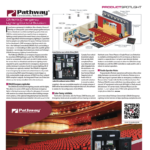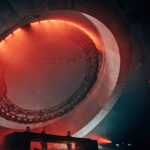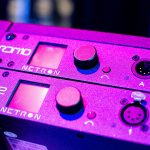When the price of fuel began its dizzying ascent a few years ago, few of us could have predicted the far reaching implications. But it might not have been so difficult to predict that the truck pack would become more important than ever, especially for those of us who have to pay the fuel bills. Upstaging, Inc., who is planted firmly both in the lighting and trucking side of the business, understands as well as anyone the implications. That’s one of the motivating reasons that they helped develop the new High-Performance Utility Design (HUD) Truss. HUD Truss is like other pre-rigged truss in many ways; it’s fabricated using 6061-T6 aluminum alloy, it has 2-inch chords, the familiar cross members, it goes together using spigots and it rides on casters. But in other ways it’s very different.
For starters, it is squattier than typical trussing, meaning it can fit in tight spaces. At 14 inches high and 24 inches wide, it just about perfectly houses most any automated lighting base, leaving the yoke and head free to pan and tilt. The lower profile of the truss allows it to better fit into hotel ballrooms and venues with a low ceiling. The width was chosen to allow the truss to fit four across in a standard truck, instead of three across as with 30-inch-wide truss. In traveling configuration, these trusses can be stacked two or three trusses high in the truck, depending on how much weight is rigged in them and how big the fixtures are that are rigged in the truss. The wheels are on removable legs that form a dolly for transport and they can be adjusted in height to accommodate the lighting. The casters are also high enough to be able to clear ramps without bottoming out. And instead of riding aluminum on aluminum, HUD Truss uses ultra high molecular weight plastic (UHMW) locaters to keep the trusses stacked and locked in place. UHMW is a type of plastic that has very high impact strength, is corrosion resistant, self-lubricating and resists abrasion. Daric Bassan, who has been using the truss on the Neil Diamond tour, reports that they have been able to forklift them from the ends of the truss, saving time on the in.
The truss has a top center chord running the length of the truss that allows automated or conventional fixtures to be loaded so that it keeps its center of gravity in the center of the truss. Another important distinction is the lighter weight of the truss. A 10 foot section weighs 200 pounds with the removable rolling legs in place and 142 pounds without the legs. The combination of the lower weight and maximum truck pack helps to make the most of your fuel dollars.
When it comes time to assemble the rig, the sections can be wheeled in straight off the truck, pieced together with spigots, “wired and fired,” and flown to height. The wheel dollies can either be removed altogether, or they can be rigged on top of the truss to form hand rails or just stored out of the way.
There is also a hinge accessory that allows two or more sections of truss to be hinged to form any angle. They can be loaded in the truck without having to remove the hinges because they can fold back 180° without increasing the width of two sections of truss. The truss is available in five-foot, eight-foot and 10-foot lengths, or they can be ordered in custom lengths.
HUD Truss was conceived by John Huddleston with input from a number of working industry professionals. It was designed and fabricated by Tyler Truss and it is now working on a number of tours and events, including Radiohead, Neil Diamond, Walking with Dinosaurs, AC/DC, Cheetah Girls and several corporate events.
Tyler Truss Systems, Inc. is now offering the patent-pending truss and accessories for sale. The accessories include two patent-pending items: the Tyler Mount — a mechanical shock and electrical isolation mount to protect the lights as they ride in the truss — and a custom cable management tray. And according to Tyler Truss President Mark Dodd, there are more products in development.
HUD Truss is gaining a reputation for saving truck space, fuel and time and for easing the arduous task of loading large lighting systems in and out of truck and venues. In today’s economic environment, every dollar and every gallon of fuel saved is highly valued, and this truss is a good value proposition for the industry.


